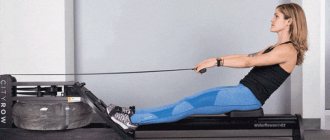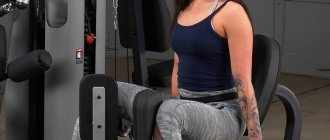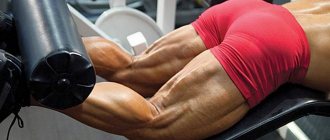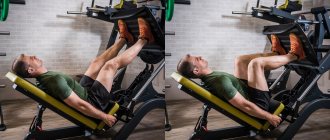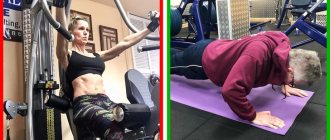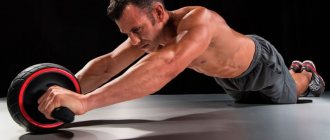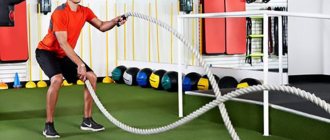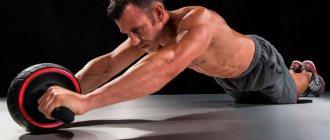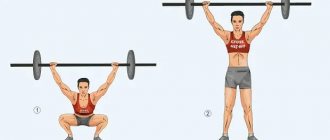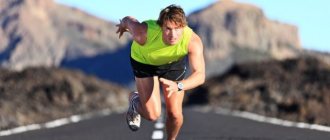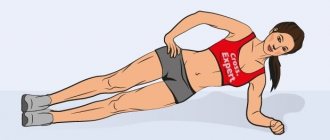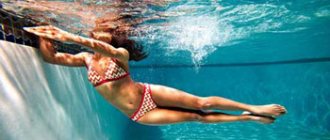Seated leg raises are an isolated exercise familiar to every gym goer. It is aimed at working the gluteal muscles, as well as the outer thigh. Although this element cannot replace the main training, it is definitely worth including it in the training program in order to further improve the shape of the hips and waistline, making them attractive.
What is leg abduction in a simulator?
This exercise is simple, and it’s almost impossible to make a mistake when doing it. It represents the movement of the legs relative to the body. Initially, the hips are spread apart, then they need to be brought closer to each other, overcoming the resistance of the rollers. The information in the simulator does not apply to all movements required. They do not train the entire thigh area or promote fat burning or weight loss, so they must be performed in conjunction with other exercises.
Such simple auxiliary movements are quite within the power of girls with any physical fitness. All you need is to choose the right load that suits your capabilities. The exercise is especially effective if combined with leg extensions. To do this, you will need the same machine to use different muscles.
Benefits and contraindications of the element
The comparative table describes all the advantages and disadvantages of the exercise.
| Advantages | Contraindications in which the element must be performed with extreme caution |
| Isolated work of abductors | Injured back |
| Working out the small thigh muscles | Lower back pain |
| Support for toning the muscles of the outer thighs | Hip injuries |
| Abductor muscle development | |
| Improving blood circulation in the pelvis |
Leg extensions in a machine is the criticism of this exercise justified?
If you talk to bodybuilders about the machine leg raise exercise, you will most likely hear that it is completely useless. But this only reveals the incompetence of the one who says so. There are no useless exercises - there are those who do not know how to perform them correctly and combine them with others.
Why is there so much negativity towards leg raises? There are some reasons for this. Firstly, the main muscle that is involved is the gluteus medius, and this muscle is not particularly large. It’s quite difficult to pump it up, so your butt won’t become much rounder. Secondly, the middle gluteus will spend much less energy than the large gluteus, so the effect for fat burning is also not the best.
So why is this exercise needed and who should do it?
- For beginners who simply cannot handle the heavy compound exercises that produce the strongest anabolic response. To bring the muscles of the butt into sufficient tone for more difficult work - quite good.
- Girls (and this exercise is traditionally considered female) who have already acquired a figure close to ideal with the help of fitness, but it needs polishing. It happens that it is the gluteus medius muscle that lags behind, and it still needs to be “pumped up”.
These are the ones who will need it the most. But in general, this exercise is good to use as an auxiliary exercise - for preliminary fatigue or “finishing off” the gluteal muscles. So, when performing the exercise, the following are involved:
- gluteus medius (main);
- gluteus maximus (auxiliary);
- tensor fascia lata (auxiliary).
Shifting emphasis allows you to use one or the other to a greater extent.
Execution technique
Set a comfortable weight. It's better to start with one tile. Sit in the exercise machine, place your feet on the footrests, rest the lateral surface of your thighs on the “pads”, which, in fact, need to be spread apart. Lean your back on the back of the seat, bend your lower back, and inhale. As you exhale, with a powerful effort, spread your legs to the sides, overcoming the resistance of the simulator. Pause for a split second in the maximum extension position. As you inhale, bring your legs back together, always with a controlled movement, and not succumbing to the pressure exerted by the “pads.”
Everything is very simple. No additional equipment other than regular sportswear is needed. The likelihood of getting injured tends to zero - exercises in machines where there can be only one trajectory of movement are safe.
Accents in execution
If the machine allows you to change the angle of the backrest, experiment with it. The further you tilt it back, the better the gluteus minimus and medius muscles will engage. If you place it straight, then part of the load will fall on the top of the gluteus maximus muscle. This effect will be enhanced if you bend forward - this will stretch the muscles a little more. A good practice is to additionally contract the muscles at the moment of maximum hip extension.
Useful tips
Since this exercise is largely isolating and uses fairly small muscles, there is no point in doing it in a strength mode, when you can handle 6-10 repetitions. It is for multiple repetitions of 12-15 times. You can add a tile if you have already done it 25 times, but there is no severe fatigue or burning sensation in the muscle yet. As we already wrote above, leg extensions in the simulator are an auxiliary exercise and can be combined well with others into supersets and trisets.
For example, if you perform it 20 times with a peak contraction of the gluteals, so that they get slightly tired, and after that go for the Romanian deadlift (aka “dead”, aka with almost straight legs), the second basic exercise will more accurately hit the target muscle group. You can also leave it for the very end of the workout, when there is no longer any strength or coordination left to perform technically complex exercises.
Especially fanatical adherents of intense training use the exercise for ... rest between more complex approaches. This approach is, in principle, also possible.
Dilution is also useful for circuit training aimed at burning fat. Since they are carried out using the “one exercise after another without rest” method, a person gets tired quickly, and it is difficult for him to do something complex. In this case, the most energy-consuming and demanding tensions of the central nervous system are placed at the beginning of the “circle”, and this is at the end. It helps not to reduce the intensity, but partially relieves the load.
Who is the element useful for?
The exercise itself will not be able to properly pump up the buttocks and thighs - you need a whole complex of elements. But for two categories of students, the training will be very useful:
- Beginners. For those who visit the gym for the first time, it is very difficult to master all the machines. Raising your legs will tone your muscles and make it possible to easily cope with further loads.
- Girls. Girls often set themselves the goal of obtaining rounded buttocks. Systematic mastery of the simulator will allow you to achieve this result. Moreover, the gluteus medius muscle is involved here, which is not worked in all elements, but has a colossal contribution to the development of beautiful buttocks.
- Men. For men who are seriously involved in sports, the element can be used to warm up the lower body before the main exercise.
What muscles work?
90% of the dynamic load falls on the calf muscles. The remaining load is distributed between the spinal extensors, trapezius muscles, quadriceps and buttocks.
For the full development of the lower leg muscles, you also need to train the soleus muscle, located under the gastrocnemius. For this, calf raises while sitting in a machine are best suited. When the soleus muscle is well developed, it visually “pushes” the gastrocnemius muscle outward, and it takes on a more peaked shape. The story is approximately the same with the posterior and middle bundles of the deltoid muscles.
Makatserchyk - stock.adobe.com
Harm
Let us immediately ask you to note that we are not declaring that this simulator is harmful. Exercises on this machine are useful in moderation with small weights and a small total monthly volume of their use. They really create muscle tone in the abductor and adductor muscles of the thigh, improve the tone of the gluteus medius and minimus muscles, and improve blood circulation in these places.
However, they do not remove excess fat at all and, moreover, these exercises can even be harmful.
(Degree of tediousness: acceptable)
We have already mentioned that the range of motion in this simulator is unnatural for the body, i.e. This movement is not used anywhere outside the gym. And the adductor muscles themselves (which this exercise is aimed at) do not work very much in life. These muscles are a complex of muscles located deep on the inner surface of the thigh and groin. They are difficult to find, because... they are “buried” under other muscles, such as the quadriceps. You use these muscles when climbing stairs, climbing hills, and standing up. Progress in weight comes quite quickly, but the higher it is, the more it strains the spine. The kneecap will also not thank you for the ever-increasing load.
How to reduce the stress on your knees when playing sports?
Thus, it turns out that no matter how you use the leg adduction machine, it most likely will not change your leg composite composition, for these purposes it is a useless tool. And it's all about the biomechanics of movement. The design of the exercise machine itself is sedentary, so the thigh muscles do not work in any way in this position. It often happens that people come to the gym after a hard, sedentary day in order to get their blood flowing and tone their muscles.
And, oddly enough, they choose on their own (or on the advice of a trainer) a sedentary machine to train their muscles. This is not true. Exercises that require balance and use free weights and weighted walking/standing should be selected. In particular, leg tucks can be replaced with cross lunges or leg abductions on a block - they allow you to achieve significantly better “tuning” of the legs.
What has been written should not be taken as a complete failure of the adductor simulator to work the corresponding muscles.
The main harm is that when you spread your legs in the exercise machine in a large volume, and especially with good weights, the piriformis muscles gradually develop and spasm .
The origin of the piriformis muscle is on the anterior surface of the sacrum, and it is attached to the femur. The function of the piriformis muscle is abduction and supination of the hip. Below the piriformis muscle is the sciatic nerve , the longest nerve in the body, running from the lower spine, through the buttocks and thighs, and down the back of the leg. Although this nerve is found in both legs, symptoms of a pinched sciatic nerve usually appear in only one leg.
Have you ever felt, when performing this exercise, that your thigh was “cramping” , some kind of aching pain when moving to the sides, deep inside? No, this is not a muscle that you pumped up so well, it’s a poor nerve asking for mercy.
Pinching symptoms:
- The very first symptom of a pinched sciatic nerve is pain, which usually begins in the lower back and spreads along the entire length of the nerve: through the buttocks, to the thighs and calves. The intensity of pain can vary from mild to very acute. Sometimes the pain manifests itself in the form of a burning sensation, in other cases it can be similar to electric shocks.
- Another common symptom of a pinched sciatic nerve is numbness that affects part or all of the leg. Numbness in one area may be accompanied by pain in another. In addition, usually a person also experiences a characteristic tingling sensation in the toes.
- One of the most distressing symptoms of a pinched sciatic nerve is loss of bladder or bowel control. This condition is rare and requires emergency medical attention. Sometimes this symptom of a pinched sciatic nerve is accompanied by lumbosacral radiculitis.
When the legs are brought together in the simulator, with a spasmodic piriformis muscle, even greater compression of the sciatic nerve occurs and symptoms worsen or appear.
Conclusion : this machine can be used in your training program, but with light weights and a maximum of 1 time per week.
Another exercise option
In addition to the classic variation of the leg raise in the simulator from a sitting position, there are other ways to perform the exercise. For example, it can be done with the body tilted forward.
The technique is not very different from the previous version, except that in this case the back must be held not straight, but at an angle:
- Sit on the exercise bench. Bend your body forward, bringing it closer to your hips. In this case, the pelvis must be shifted to the edge of the seat. Place your hands on the counter.
- Inhale, tense your abdominal muscles. Exhale and spread your legs to the sides. Hold the position for a few seconds.
- Take the original position.
On a note! By adjusting the inclination of the backrest of the machine, you can transfer more or less load to the lower or middle part of the buttocks. In addition, there is a variation of the exercise when the body is tilted back or the buttocks are lifted off the chair.
Inclusion in the training plan
Despite the fact that the person in the machine sits with his knees bent, the exercise is considered a single-joint exercise. In the absence of injury, it is usually included in the general program after multi-joint leg development (for example, squats or platform presses). Care should be taken to select the load, not placing a weight that the athlete is not able to lift more than 10 times.
It is permissible to perform this exercise separately several times a week. You can do it every day in combination with squats if the goal is to correct your squat technique.
It is contraindicated to do leg extensions/reductions under load in case of injury to the hip joints, as well as inflammatory processes. This restriction applies until the moment of rehabilitation - when power loads are allowed. This exercise is performed under the guidance of a trainer for osteochondrosis and hernias in the lumbar spine. Any back twisting is avoided.
Execution technique
Usually, beginners are advised to extend their shins in the simulator only because it is impossible to make a mistake in this exercise. This is where internet experts are wrong. A beginner can make mistakes everywhere. For example, some individuals do not know that the back of the exercise machine is adjustable, and the support cushion can also be adjusted. They sit on the edge of the seat and strongly “push” their ankles under the car seat. From this position, the ACL turns out to be overstretched at the start. Therefore, such “techniques” are not recommended for fitness.
In order to do the exercise correctly, you need to:
- Adjust the backrest so that it is a support. Most exercise machines have an adjustable backrest and the ability to move it in and out;
- The correct starting position is that the back rests on the backrest, the thigh lies on the seat, the lower leg is fixed with the pad of the exercise machine, and the angle between the lower leg and the thigh is no more than 90 degrees;
- In rehabilitation, incomplete amplitude is allowed when the roller is attached higher than 90 degrees;
- The toes should be pointed slightly towards you; it is better to start the exercise by contracting the quadriceps
These are SEATED LEG EXTENSIONS, baby!
Watch this video on YouTube
The movement is performed as follows:
- The downward movement should not be forced, it is better to lower smoothly and smoothly straighten the lower leg;
- The back should be pressed completely against the back, the lumbar region too;
- Extension should be done while exhaling, flexion – while inhaling.
The variations are actually very diverse. The simplest thing is extension of one leg at a time. This version is for those who have imbalances in the development of their legs, and always “starts” with one hip, only finishing with the other. This option for performing the exercise is better suited if the athlete is afraid of the ACL, or already has injuries.
The second variation is extension with rubber. Sitting on a chair, the athlete extends his lower leg while fixing the rubber shock absorber on the foot. This option is suitable for those who need to strengthen ligaments and protect themselves from injuries.
The third variation is for those who do not have an extension machine. A plate is placed on the shins, the athlete sits on a chair. This option strengthens the ankle and soleus, since the weight will need to be supported by the ankles.
The fourth variation is an extension with the toes turned outward and the heels inward. There is an opinion that this technique builds more rounded hips in girls whom nature has endowed with an I-shaped figure.
Fifth – toes inwards, heels outwards. This is a rather controversial position of the feet from an anatomical point of view, but some athletes believe that this way they better work the medial head of the quadriceps.
Be that as it may, the success of this exercise lies in controlled technique, no jerking or pushing, and slowly raising and lowering the weight. Control the movement of the roller, and the exercise will not be traumatic for you.
The movement is usually performed for 12-15 or more repetitions, in 3-4 working sets; they do not work in power mode
What to combine with?
Exercises on this machine can be used as auxiliary to the main ones (or rehabilitation in case of injury) and included at the end of the workout , but working only with it will not give any progress in improving the shape of the legs, remember this and do not fall for the machine as an exclusive one for training muscles inner thigh.
I think a reasonable question has arisen: why are such not very effective exercise machines installed in gyms? The answer is that if they did not exist, fitness centers would discourage most of their female clientele from visiting them. Coupled with the fact that women are afraid of free weights and becoming too big and muscular, it is easier for them to choose a light load for themselves.
So ladies, when it comes to improving the shape of your inner thighs, use the adductor machine wisely and don't focus on it alone.
Benefits of seated calf raises
- Targeted load on the muscles of the back of the lower leg. In particular, on soleus. Their development will visually increase the calf muscles. Making them more voluminous.
- The axial load on the spine is reduced. What makes the exercise less traumatic.
- The calf muscles will become stronger. Which will have a positive effect on increasing weight in basic exercises for the leg muscles.
- You can perform the exercise not only in the simulator, but also with free weights. If your gym doesn’t have special equipment for developing calf muscles, it doesn’t matter. We take a barbell or dumbbells and do calf raises while sitting.
- The development of the lower leg muscles will help improve results in disciplines such as running and jumping. Therefore, track and field athletes pay a lot of attention to training their calf muscles.
Just one exercise provides so many benefits. All that remains now is to master its technique and choose the option that will be your assistant when training your calf muscles.
Results
Many people do not like training their legs, because these are the most capricious muscles that require constant experimentation to determine the optimal formula for increasing strength and volume indicators. At the same time, leg training is exhausting.
Finally, we’ll give you some advice: if you use split training, give your legs a separate day, and if you don’t have enough load, work out small muscle groups, for example, the calf muscles.
Author Ivan Tungusov
Project expert. Training experience – 12 years. A good theoretical basis on the training process and proper nutrition, which I am happy to put into practice. Need a recommendation? This is for me
